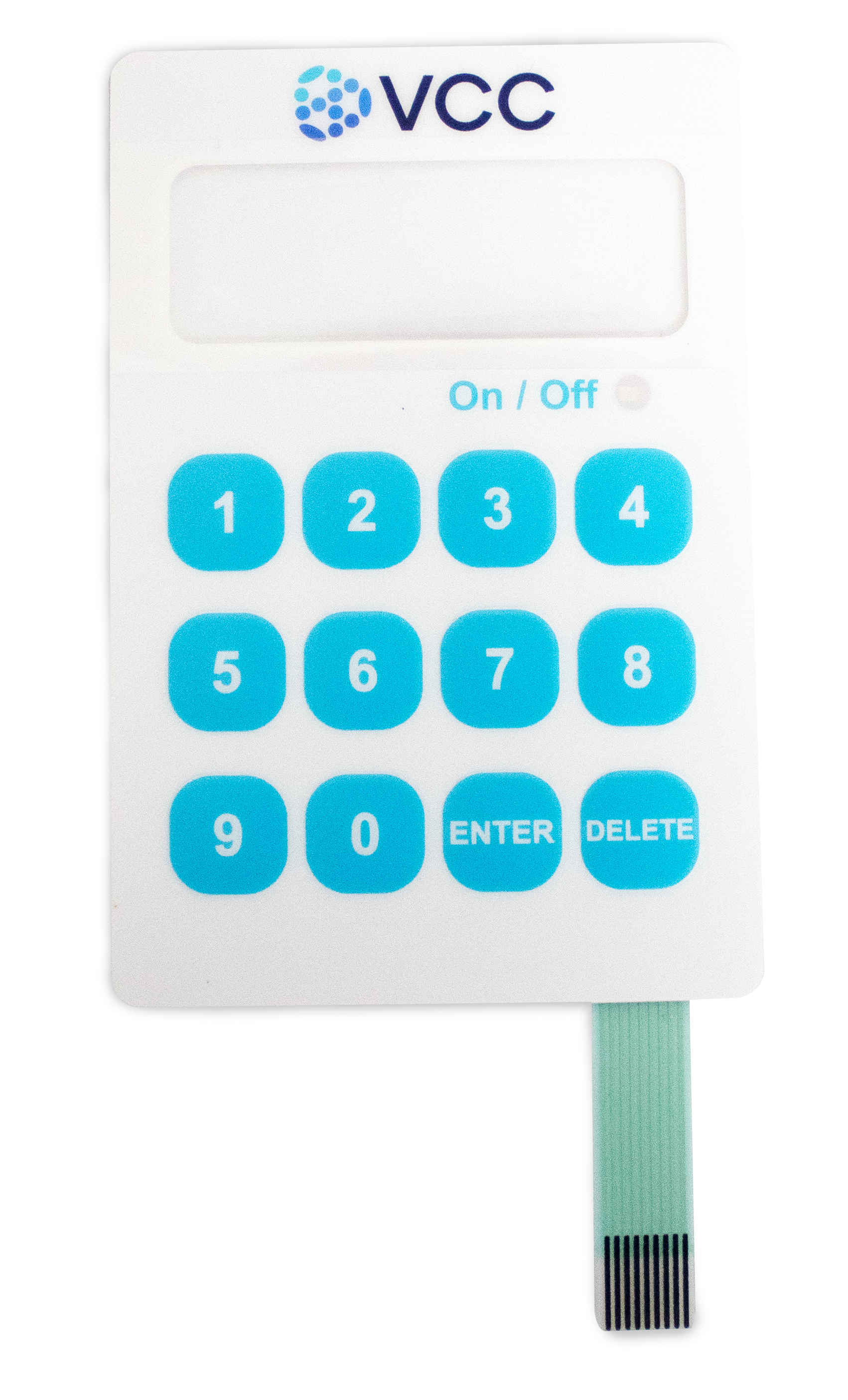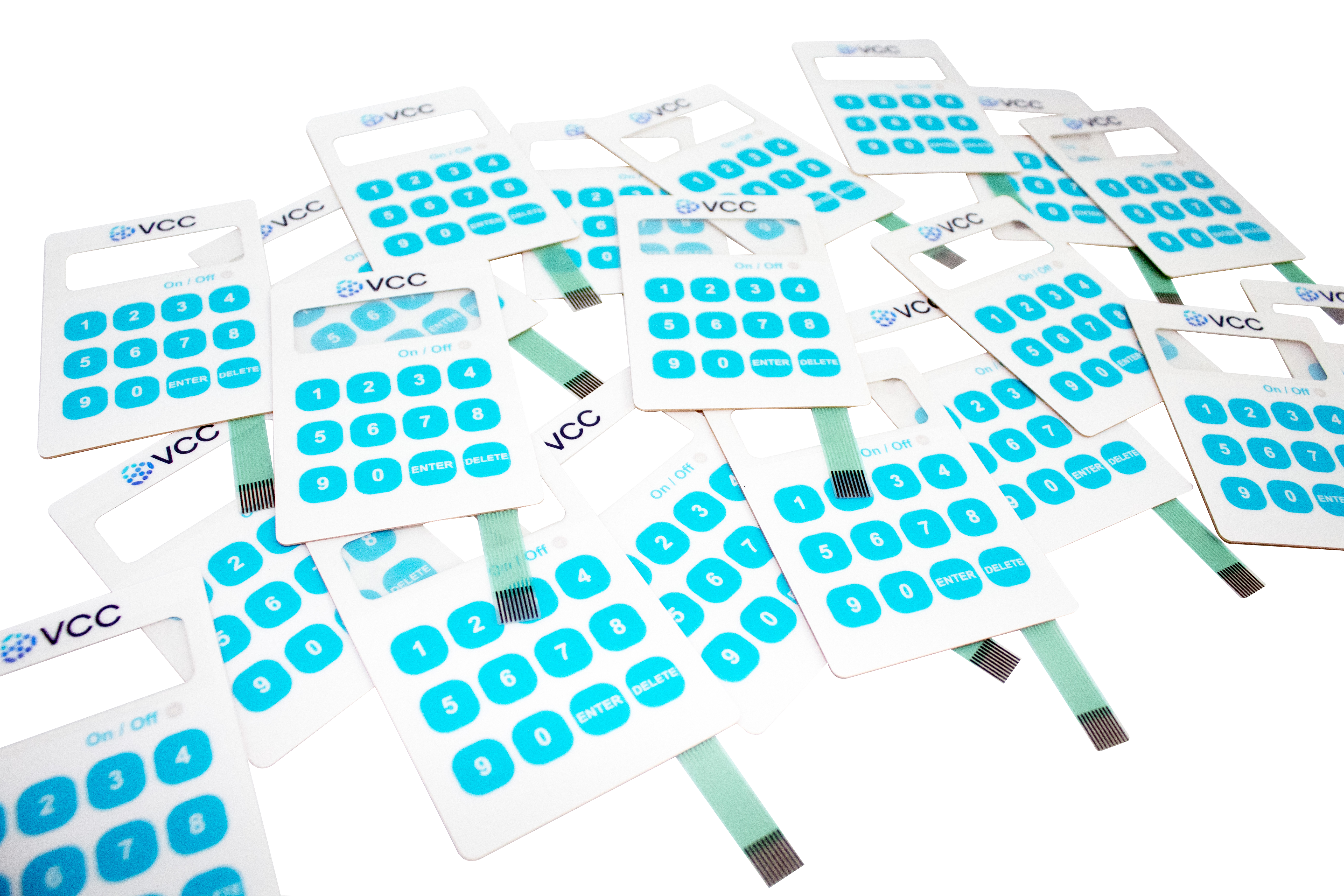Membrane Switches
A low-profile, durable interface used to control electronic devices, consisting of multiple layers that create an electrical connection when pressed.
What is a Membrane Switch?
A membrane switch is a custom electrical switch assembly that uses pressure or contact to open or close a circuit.
It consists of multiple flexible layers of polymer films and adhesives. The layers typically include a graphic overlay, 2 spacer layers, a circuit layer with conductive traces, and a mounting adhesive. When a user presses a button on the graphic overlay, the button contacts the conductive traces on the bottom layer, completing an electrical circuit and registering the input



Extensive Design and Manufacturing Capabilities
With nearly 50 years of HMI design and manufacturing expertise, partnering with VCC ensures your membrane switch is designed and manufactured to your exact needs, with the quality you expect from a trusted partner.
Whether your design is for consumer appliances, medical equipment, surgical devices, smart home technology, or industrial controls, VCC offers high-quality membrane switches to meet your application needs.
Adhesives for membrane switches:
Selecting the right mounting adhesive for your membrane switch is an important design consideration. 3M 467 and 3M 468 are industry standards for bonding to surfaces like aluminum, steel, ABS, polycarbonate, and nylon. Low surface energy adhesives like 3M 300LSE are used to bond to more tricky substrates like powder-coated metals, and polypropylene. Key characteristics to consider when choosing an adhesive include the smoothness (or roughness) of the substrate, environmental resistance to temperature, moisture, and UV, as well as compatibility with the specific substrates (e.g., metal, plastic) that the mounting surface is made of.
3M has a great graph that shows the surface energy of various materials.
Circuitry options for membrane switches:
Membrane switches are most typically made with screen-printed silver circuitry on PET. These circuits are durable and have been used in membrane switches for over 30 years. While screen-printed silver circuits are a viable option for many membrane switch designs, there are some limitations with this type of circuit. Screen-printed silver circuits are usually terminated with 2.54mm pitch female headers or 1mm pitch ZIF connectors. Some surface-mount components, such as LEDs, can be mounted on this type of circuit, but the components must be at least 0603 (1.6mm x 0.8mm) or larger.
Copper on polyimide flex circuits are used in membrane switch applications that require finer pitch ZIF tails, multi-layer circuits, or many small surface mount components. Typically, this type of circuit construction is more expensive than screen-printed silver on PET; however, it allows for more complex designs and greater reliability when small components are required.
Membrane switches can also be built on traditional FR4 PCBs. One significant advantage of this construction is that you can have any connector that you want on the back of the membrane switch assembly. This is great for applications that require specialty connectors or where discrete wires are needed.
What are the Benefits of Using Membrane Switches?

Thin and Lightweight:
The low profile and compact design make membrane switches ideal for space-constrained designs.

Durability and Long Lifespan
Sealed design provides superior moisture resistance while being easy to clean and maintain.

Flexible Design and Integration
Custom graphics, backlighting, and tactile feedback enhance usability with clear visual and tactile cues.

Cost Effectiveness
Offer lower entry costs than mechanical switches or touchscreens, with attractive pricing and minimal tooling.
What is the Membrane Switch Design Process?
Step 1: Engineering Drawing
Our engineers work with customers to determine the application, environment, dimensions, and number of buttons needed. This process includes selecting appropriate materials for each layer, designing the circuit configuration and termination method, defining the visual interface, including colors, symbols, and textures, and finalizing additional features, such as tactile feedback, backlighting needs, and any integrated components like LEDs or displays.
Step 2:Prototype and Test
Based on a defined specification, a prototype is produced and tested to evaluate its functionality, aesthetics, and durability.
Step 3: Refine Design
The prototype phase is imperative to ensure the design meets the exact specifications. If any necessary adjustments are needed, we conduct a design iteration to ensure it meets the customer’s requirements.
Step 4: Finalize Design & Manufacturing
Once the design is finalized, the details are documented and approved by the customer, and mass production begins.
What are the Advantages of Membrane Switches?
Membrane switches offer numerous benefits, making them an excellent choice for electronic control. They are thin and lightweight, making them ideal for designs where space is limited. Their durability and long lifespan come from a sealed design that provides superior moisture resistance and makes them easy to clean and maintain.
Furthermore, membrane switches offer flexible design and integration options, allowing for custom graphics, backlighting, and tactile feedback to enhance usability through clear visual and tactile cues. Finally, they provide cost-effectiveness, often having lower entry costs compared to mechanical switches or touchscreens, along with attractive pricing and minimal tooling requirements.
What Industries Use Membrane Switches?
We provide high-quality membrane switches to a variety of industries. In aerospace, our switches are used for cockpit controls, avionics, and onboard systems. For industrial applications, they are found in heavy-duty equipment, as well as test, measurement, and diagnostic equipment. In the medical field, our switches are critical for various medical devices. We also cater to the IoT sector for smart home appliances and industrial IoT applications. Furthermore, our switches are utilized in the energy sector for renewable infrastructure, power generation, and industrial energy management, and in transportation for transport and communication devices.













